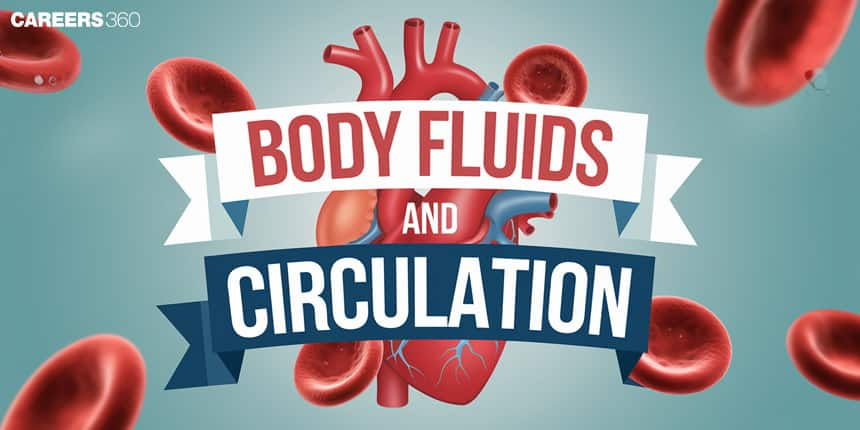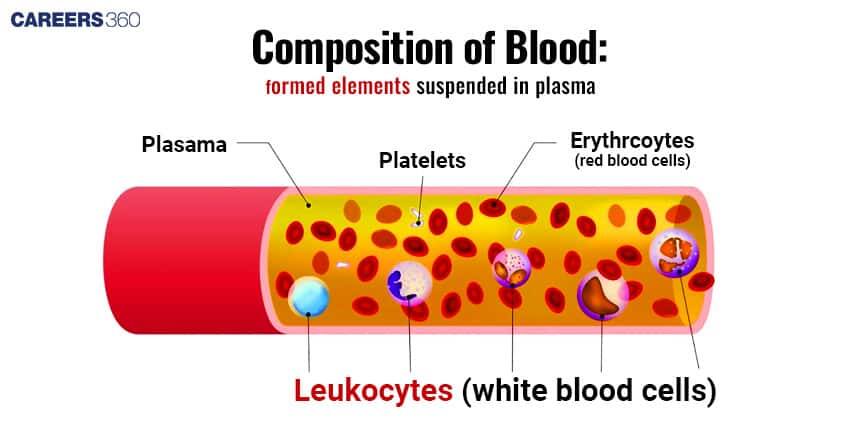Body Fluids and Circulation
Body Fluids and Circulation explains how the body transports nutrients, oxygen, and waste using fluids like blood and lymph. It includes the study of the heart, blood vessels, and how blood flows through the body. Understanding this is important for learning concepts in human physiology. This topic helps us understand how the body works and is important for learning biology and preparing for exams like NEET.
This Story also Contains
- What are Body fluids?
- Types of Body Fluids
- What is the Circulatory System?
- Composition of Blood
- Blood Groups
- Circulatory Pathways
- Human Circulatory System
- Disorders of the Circulatory System

Body fluids and circulation explain how complex the human body is and its dependence on the efficient transport of nutrients, gases, hormones, and waste products to maintain a healthy life. Understanding the mechanism of circulation, disorders of the circulatory system, and the different types of blood groups is really important in knowing how the body works.
What are Body fluids?
Body fluids are the important body liquids that either circulate or are drained out from the body. There are two types: intracellular, which is the fluid inside cells and extracellular, which contains lymph, blood plasma, and fluids surrounding organs. The main fluids in the body are blood, gastric juice, cerebrospinal fluid, saliva, semen, mucus, and urine, each of which has a distinct function, such as transportation, digestion, protection, or waste removal.
Also Read:
Types of Body Fluids
After understanding what body fluids are and how they have their own distinct body functions, it becomes necessary to know the types of such fluids that exist in the body. Here are the major types:
Blood and lymph are the most important body fluids. Human blood is the fluid of connective tissue that includes white blood cells, red blood cells, plasma, and platelets.
Due to the presence of haemoglobin, blood is usually red.
Blood flows in two ways - from the heart to the muscle and from the muscles to the heart.
Lymph, on the other hand, is a clear fluid that circulates within the lymphatic arteries and is also known as tissue fluid and interstitial fluid.
Functions of Body Fluids
These are among the few functions of body fluids.
Transport of essential nutrients and oxygen to all vital organs.
Removal of toxic waste.
Body temperature control.
Control of metabolism.
What is the Circulatory System?
The circulatory system forms it all. It's a means by which the body fluid is moved containing important substances like oxygen, nutrients, and waste around the body. Knowledge about constituents and functions of body fluids and circulatory systems is of the essence in maintaining health and identifying disorders associated with them.
Blood
Blood is a specialized type of connective tissue. It is a strictly basic part of body fluid.
Blood's chief functions include transportation, protection, and regulation.
Lymph
Lymph is the clear fluid moving through a lymph vessel, which belongs to the immune system.
It clears the tissues of waste and toxins or other debris with the transportation of WBCs in and out of the lymph nodes.
Composition of Blood
Blood is a vital connective tissue that plays a key role in transporting substances throughout the body. It is composed of a liquid part called plasma and cellular components known as formed elements, each with specific and essential functions.
Plasma
Plasma represents the fluid part of the blood, it forms about 55% of the entire volume of blood. The prime content of the plasma is water. Besides that, it also contains proteins, electrolytes, nutrients, hormones, and waste products.
Formed Elements
The formed elements in blood are composed of erythrocytes, leucocytes, and platelets.
Erythrocytes
This is meant to carry oxygen from the place of loading, the lungs, to the different parts of the body and then return with the carbon dioxide to the lungs, which will then be exhaled.
Leucocytes
Popularly known as white blood cells, they form a part of the immune system, which fights various kinds of infections or diseases in the human body system.
Blood Platelets
These are small portions of cells whose responsibility is taking crucial clotting of blood and healing of wounds.
Here is a brief table showing the components of blood:
Components | Functions |
Plasma | Transports nutrients, hormones, waste |
Red Blood Cells (RBCs) | Carry oxygen via hemoglobin |
White Blood Cells (WBCs) | Fight infections |
Platelets | Help in clotting of blood |
Blood Groups
There are different types of blood group based on the concept of presence or absence of antigen and antibody. Blood grouping becomes very important and relevant not only for safe blood transfusions but also for understanding the aspects of immune responses.
ABO Blood Group System
The ABO blood group system occurs in four different varieties or groups where the antigens of the red blood cells are distinguished A, B, AB, and O blood groups. Here is a brief table showing different blood groups along with their compatibility:
Blood group | Can donate to | Can receive from |
A | A, AB | A, O |
B | B , AB | B, O |
AB | AB | A, B, AB, O |
O | A, B ,AB, O | O |
Rh Grouping
The Rh grouping is based upon either the presence or absence of an antigen known by the name Rh factor. According to the presence of this type of antigen, a person is Rh-positive or RH-negative.
Coagulation of Blood
Coagulation is a process during which blood vessels dilate and blood clots are formed, attempting to prevent the excessive loss of blood if a vessel is injured.
It is a complex cascade of events that results in the conversion of fibrinogen to fibrin, forming the meshwork of the clot.
Circulatory Pathways
The circulatory system is responsible for transporting blood and nutrients throughout the body. It can be of two main types: open and closed, based on how blood flows within the body.
Open Circulatory System
Blood is such that it does not always circulate within blood vessels. it flows freely off cavities, bathing organs directly.
Closed Circulatory System
Blood remains inside vessels, leading to further efficiency of substance transportation. The human circulatory system along with all other vertebrates works this way.

Human Circulatory System
The circulatory system of humans consists of the heart, the system of blood vessels, and blood. All these components together play an important role in the circulation of body fluids, hormones, and other substances.
Heart Structure
The heart is a muscular organ with a four-chambered structure, including two atria and two ventricles. It pumps blood across the body parts.
Nodal Tissues
Various nodes and tissues present in the heart are the sinoatrial and atrioventricular nodes. These nodes give rise to impulses, which regulate the heartbeat.
Blood Vessels
Blood vessels are made up of arteries, veins, and capillaries. Blood leaves the heart through the arteries and returns to the heart through veins, in turn, the capillaries are the sites of delivery of material from the blood to the tissues and picking up material from the tissues.
Cardiac Cycle
It is the process of one heartbeat, involving contraction and relaxation, that continuously circulates the blood throughout the body.
Electrocardiogram (ECG)
The ECG is a diagnostic method measuring the heart's electrical activity.
It is useful in making various cardiac diagnoses and measures the rhythm of heartbeats in an individual.
Double Circulation
Double circulation is one of the features of the human circulatory system where the blood passes through the heart twice in one complete cycle. This consists of pulmonary and systemic circulations.
Pulmonary Circulation
It is the flow of blood from the heart to the lungs and backwards to the heart. This is the process by which blood gets oxygenated and carbon dioxide removed.
Systemic Circulation
The flow of oxygenated blood from the heart around the rest of the body and part deoxygenated blood back to the heart was another form of circulation.
Hepatic Portal System
Veins forming a system that carries blood from the gastrointestinal tract and spleen to the liver were used to have waste detoxified and nutrients processed.
Regulation of Cardiac Activity
The autonomic nervous system along with the endocrine system controls cardiac activity.
The sympathetic nervous system brings about an increase in heart rate, and the force of contraction, whereas the parasympathetic decreases heart rate.
Disorders of the Circulatory System
There could be different disorders of the circulatory system, thus hindering the path towards well-being. These disorders can be anything from high blood pressure and atherosclerosis to more serious conditions like heart failure. A few disorders related to the circulatory system:
- Hypertension or High Blood Pressure
High blood pressure symptoms show the pressure of the blood up against the walls of the arteries is very strong. Hypertension increases the risk of heart disease and stroke.
- Coronary Artery Disease (CAD)
It refers to the reduction or blockage of coronary arteries that supply blood to the heart muscle. Reduced blood supply to the heart makes the organ more prone to a heart attack.
- Angina
Angina is a chest discomfort arising from poor blood circulation through the heart's muscles. It is mostly a symptom or sign of coronary heart disease.
- Heart Failure
A condition in which the heart's function becomes unable to sufficiently meet the needs of the organs and tissues in the body. It results in symptoms such as shortness of breath, tiredness, and fluid retention.
- Coronary Thrombosis
This is a blood clot inside one of the coronary arteries. Such thrombosis commonly leads to a heart attack.
Also Read:
Recommended Videos on Body Fluids and Circulation
Frequently Asked Questions (FAQs)
Its major components include the heart, Blood, lungs, arteries, veins, capillaries, portal and coronary arteries.
Importance of some plasma proteins:
Globulins - Involved in the body's immune system, also called immunoglobulins
Albumins - help maintain the body's osmotic balance
Fibrinogens - play an important role in blood clotting
It ensures proper blood circulation inside the body without getting oxygen-rich blood mixed with deoxygenated.
In addition, the separation between the two types of blood even supplies oxygen to blood cells and increases the flow of blood.
Some functions are: -
Transport of essential nutrients and oxygen to all vital organs.
Removal of toxic waste.
Body temperature control.
Control of metabolism.
The components of a blood component are as follows:
Erythrocytes or RBCs red blood cells - Carry oxygen and contain pigment.
Haemoglobin - Haemoglobin combines with its oxygen and forms Oxyhaemoglobin, which carries oxygen to the oxygen-deprived areas of the human body.
Leukocytes or WBCs or white blood cells - Lymphocytes are usually known to synthesise antibodies which reduce or kill germs. Neutrophils act as a defence against viruses known as phagocytosis.
Thrombocytes or platelets in the blood - help the blood to coagulate
